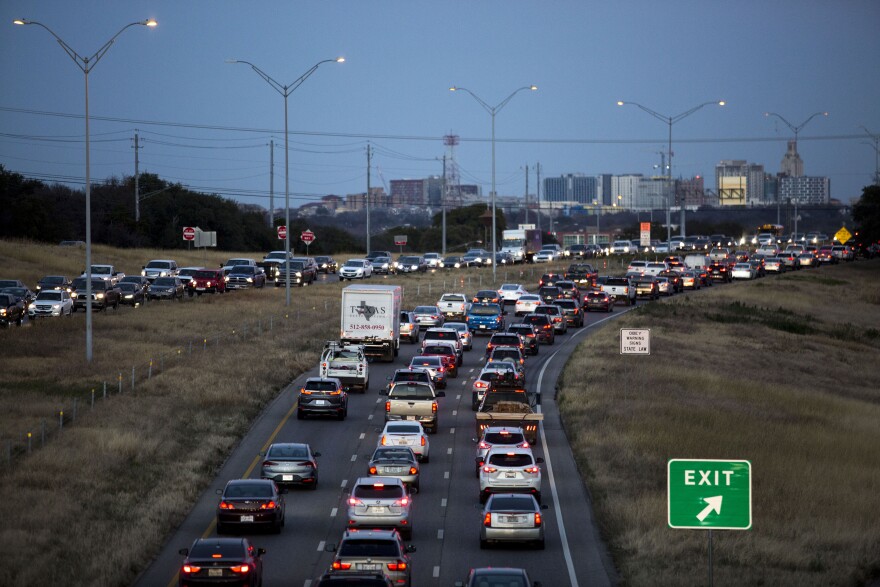This story was originally published on January 13, 2017.
Most of us ride up and down highways without giving them a second thought. But there seems to be something different about MoPac. The glorified parking lot known, at least officially, as Loop 1 has given many a driver plenty of time to ponder its quirks while stuck in traffic.
Jodi McLaughlin is one of those drivers. Like many in Austin, she says her life kind of revolves around the freeway.

"We travel MoPac almost every day because of where we live in Austin," she said, "and we have to drive to see family and friends and also to go to work and almost everything else."
And all of that time on MoPac has generated two lingering questions for Jodi, which she submitted to our ATXplained project:
What is the history of the development of MoPac-Loop 1? And will it ever really be a loop?
Right-of-Way
MoPac is an oddity because – unlike most highways – it grew from the middle out. And to get to where MoPac is going, you kind of have to know a little about where it’s been.
People have traveled up and down the MoPac corridor since the turn of the last century when the Missouri-Kansas-Texas rail line – also known as the MKT line –punched through Austin and into South Texas. Its parent company, the Missouri Pacific Railroad, controlled much of the passenger and freight rail through Texas.

It’s the railroad that gave the freeway its name – at least the name most of us call it. Missouri Pacific merged with Union Pacific decades ago, but its nickname, “MoPac,” stuck around.
Its path carved a perfect line through some of Austin’s nicest neighborhoods. Chris Bishop with the Texas Department of Transportation (TxDOT) says MoPac would have been much more difficult to build if the rail line hadn’t been there.
“The right-of-way available on MoPac belonged to the railroad, and the railroad was happy to share a little bit, so it was a huge amount of property,” Bishop said.
The idea for a highway along the MoPac tracks first pops up in Austin in the early 1940s. It wasn’t until 1961 when city officials put designs on paper. Austinites were just getting used to the north-south interstate on the other side of town. West-siders, sick of having to tarry up and down Lamar Boulevard, wanted one of those fancy highways for themselves.
But there was a catch: It had to stay within the footprint of the railroad north of what was then Town Lake.
Finally, in 1969, workers broke ground, staying basically within the boundary offered by the train line. Six years later, a quirky little freeway was born.
When engineers designed the original MoPac in the 1960s, their goal was to get commuters from on the West Side of Austin to and from downtown.

The result is an engineering feat or a nightmare, depending on your perspective. A spaghetti bowl of highway lanes, entrance and exit ramps, sidewalks, local traffic overpasses, hike and bike trails and footbridges. Throw in a creek and a lake to boot. It was then that the city realized it must go further.
"You never move forward with unanimity or very rarely move forward with unanimity, but you got to move forward,” former Austin Mayor Carole Keeton said. “And I certainly felt like it was important that we extend MoPac from Town Lake to 183.”
Keeton served on the Austin City Council when MoPac opened in 1975. The highway’s extension to Loop 360 was completed during her second term as mayor, and the push north began – a tough sell for some of Austin’s most entrenched neighborhoods.
“Years later, of course, those who were most vigorously saying ‘not in my backyard’ wanted access to that extended MoPac,” Keeton said.
"It’s going to be ready at some point, and it’s going to be a lot better."
MoPac began to expand south in the '80s. That move was met with resistance from environmentalists, as it encroached on Barton Creek and over the Edwards Aquifer recharge zone. Even today, plans to construct freeway underpasses at Slaughter Lane have been met with lawsuits aimed at delaying construction for environmental impact studies.
So, we’re starting to see MoPac’s limitations. You can’t expand too much north through the middle of town because of space. Expansion south stokes environmental and water quality concerns, which means MoPac, distance-wise, may have reached the end of the line.
More recent efforts to improve MoPac by the Central Texas Regional Mobility Authority work within the existing roadway. They include adding a toll lane in each direction.
Kirk Watson has taken an interest in transportation since his first term as mayor in 1997. Watson helped lead the charge for denser development.
“I’m very proud of the work I did as mayor to change downtown," Watson said.
He also promoted the city’s tech community as a job creator. That growth engine here continues to hum along nearly 20 years later, bringing thousands of new folks to town every year and forcing many of them onto MoPac.
So does he ever drive down MoPac and wonder, "What have I done?"
“You know, me being me, I drive down MoPac and see the glass half-full,” Watson said. “On any given day, I can complain how bad a road might be, but the minute we start trying to fix it, I then start complaining about how they got things torn up. So, I try to be a glass half-full. It’s going to be ready at some point, and it’s going to be a lot better.”
Out of the Loop
There is one thing that tends to be confusing to some. MoPac’s name. There are few signs that designate MoPac as “MoPac.” All of the TxDOT signs call it by its official name: Loop 1.
A quick glance at a map, you realize that Loop 1 is anything but a loop.

Which leads us to the second question Jodi McLaughlin asked: Will it ever really be a loop?
When one hears the word “loop,” it’s probably natural to assume that it is a circle.
“A loop doesn’t necessarily have to be circular,” explains TxDOT’s Bishop. “We think it is, by definition, in the common dictionary, a loop is circular or distinctly curved. In state highway designation, a loop connects two state highways.”
Finally, some clarity from the old State Highway Department. Loops are not loops.
They just connect two state highways! Loop 1 connects State Highway 45 with State Highway 45.
I tell McLaughlin loops in Texas are not loops in the traditional sense.
“Well, that’s not entirely true,” she argues. “Houston itself has two. I think San Antonio has one, and there’s Loop 12 in Dallas.”
Actually, the loops in Houston aren’t state loops. One is designated as a beltway, which is technically not a loop.
“Well, if we’re going to talk about proper circles and things like that, I think we’re getting just a little technical, right?” she said.
It is technical.

“I think that they should maybe rename them so they’re not as misleading,” McLaughlin said. “And maybe call them connectors, because I think that that might be their actual purpose.”
That is the actual difference in highway parlance of a loop, a highway that connects one highway to another.
“Well [for] someone who doesn’t work for TxDOT or work in transportation or urban planning,” McLaughlin said, “you can see how that can be very misleading. I know I’m not the only one.”
McLaughlin's right. There are some loops around Texas that actually loop. There are a few interstates that form contiguous loops. There are only three "complete" looping state highways – none of which are here in Austin. Ours go basically in a line – Loop 1 and Loop 360 are the most famous.
So, if Loop 1 will not form an actual loop, maybe we can do something about the term loop? Maybe Watson could help.
“Frankly, how do you keep Austin weird? Maybe things like naming loops that ain’t loops is one of those ways,” Watson argues. “So, I’m not sure I want to go against keeping Austin weird and changing something that way.”
So, there you go.
Because of where it was built and where it would need to go, MoPac, or Loop 1, will not likely form a complete loop any time soon.
But never say never.
Evil Has a Name?
No look at MoPac would be complete without talking to the person who created its parody Twitter account @EvilMopacATX.
However, no self-respecting parody account owner would give a public radio reporter his or her real identity. We tried. It didn't happen.
So, Evil Mopac sat down, in character, at a coffee shop downtown to speak to KUT – because even highway parody Twitter personalities need caffeine. Listen to our conversation below:














